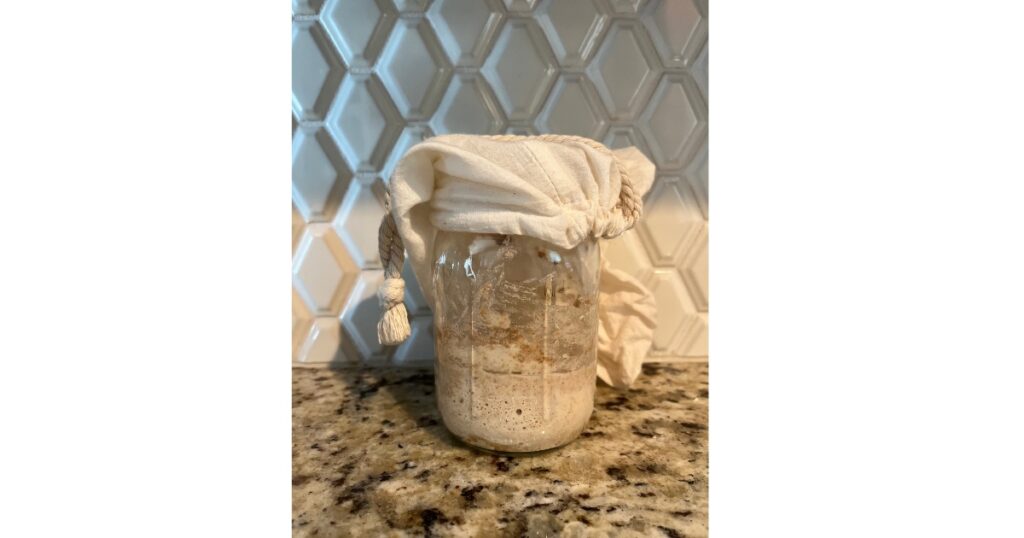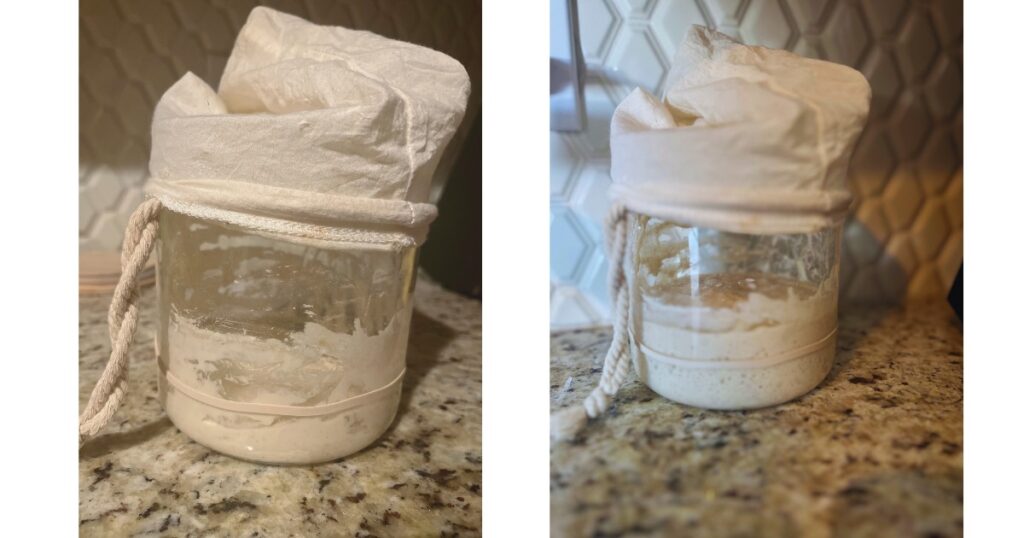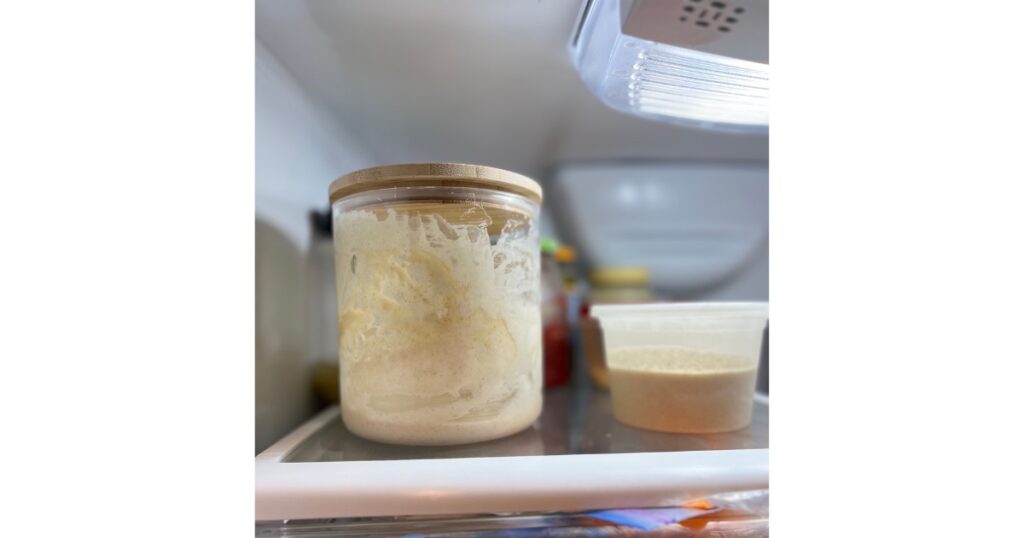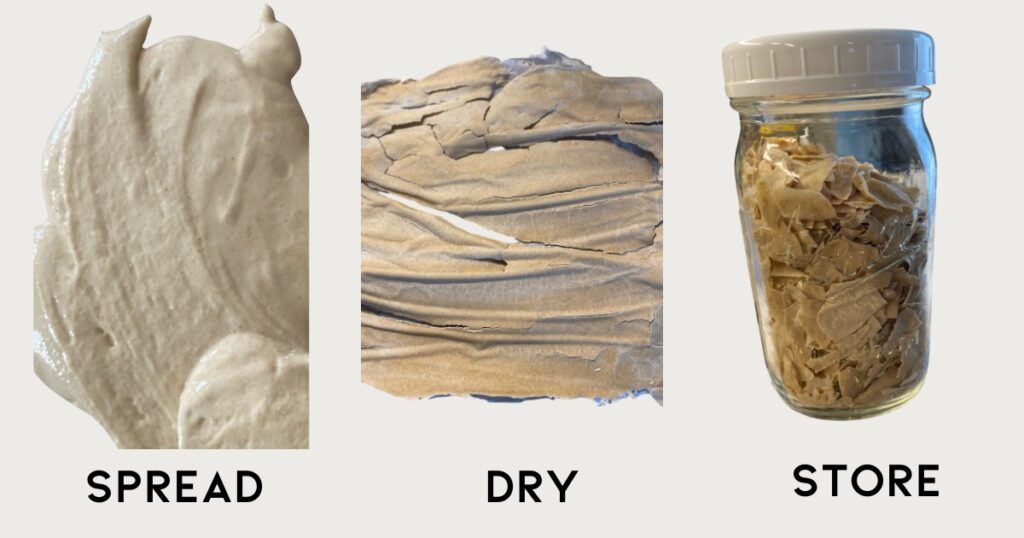It is easy to maintain and feed a sourdough starter once you have made it from scratch or received it from a friend. By choosing your preferred storage method and feeding it as necessary, you will have a happy sourdough starter at your fingertips.
If you are reading this article, you may be new to your journey with sourdough. Congratulations, I started my sourdough journey not too long ago, too! Though it can seem intimidating at first to keep a sourdough starter alive, have no fear.
It is a fairly easy process to maintain and feed a sourdough starter which will allow you to make cheap and affordable food from your whole family will enjoy. Plus, it is easy to make your own sourdough starter from scratch.

Storage Methods
There are four methods to maintain and feed a sourdough starter. These include the: countertop method, fridge method, dry method and freezer method. The countertop and fridge method are two ways to store sourdough if you are regularly making recipes.
The dry method and freezer method are long term storage options if you need to pause your sourdough maintenance for some time (IE you are sick, going on vacation, or just want a pause from the sourdough journey).
The length of time between feeding sourdough depends on how often you want to use sourdough starter within a recipe. While consistency is important, timing can change based on life needs.

Maintaining a Sourdough Starter- Countertop method
A sourdough starter can sit on the kitchen counter for roughly 24-48 hours without being fed and discarded. As a starter continues to ferment, it needs a regular feeding to ensure the sourdough stays happy and healthy. Keep the sourdough starter at room temperature in a warm spot, out of direct sunlight.
A mature sourdough starter will take a feeding ratio of flour, water and sourdough starter to continue staying bubbly. While utilizing the countertop method, it is important to feed the sourdough a daily feeding at the same time – 7:00 each morning or night. To monitor growth and when a sourdough starter is ready to use within a recipe, consider the peak.
A sourdough starter reaches its peak when it is 100% hydrated. This point is the highest level the sourdough starter rises before it begins to decline in size again.
If you are measuring your sourdough starters peak, it will be when the starter ‘doubles’ in size. To measure, you can use a marker noting the top of the recently fed sourdough starter or a rubber band. Once the sourdough starter falls below its peak and has gone flat (IE minimal (or no) bubbles), it needs to be fed again.
A sourdough starter in a warmer 65-75 degree household will reach the peak faster than a house which is cooler than 65 degrees. In the warmer months (summer) where our household is hotter, sourdough starter can take 4-8 hours before it reaches it’s peak where it may take 18-24 hours in the winter.

Maintaining a Sourdough Starter – Fridge Method
If you are looking to maintain your starter by feeding it one time a week (or will less frequent feedings), try the fridge method. Refrigerated starter does not need to have frequent feedings because the cooler temperature causes the fermentation process to.
To continue the fermentation process discard your sourdough, feed it and immediately place it in the fridge. To lessen the chances of a skin forming over the top of the sourdough starter, loosely cover it with a lid, plastic wrap or a combination of plastic wrap with beeswax wrap.
A hardened skin could form because the starter is not stirred daily. Simply stir it into your starter next time you bake or discard it in the trash.
If a sourdough starter is not fed for over a week, a thick grey colored ‘skin’ and a layer of water at the top of the starter forms, scrape this away before feeding it again. Or take a spoonful of the remaining starter from beneath the skin, transfer it to a new clean jar and feed.
It is important to feed your starter upon removing it from the refrigerator. If you are ready to make a recipe with your sourdough starter and are utilizing the refrigerator method between feeds, simply remove from the fridge, feed and allow to sit on the countertop until it has doubled in size.
It may take longer to reach peak hydration as the starter warms back up to room temperature. I typically feed my starter 12 hours before I want to begin a sourdough recipe. When you are done utilizing the sourdough starter within a recipe, either move to the countertop method or place back in the fridge upon feeding again.

Maintaining a sourdough starter – Dry Method
Drying out sourdough starter can be helpful when you need time between recipes, do not want to maintain a starter with regular feedings, or want some starter on hand in case yours bites the dust. Sourdough starter can be dried into chips before being rehydrated and used within a recipe.
To dry sourdough starter, simply spread your fed sourdough starter on a piece of parchment paper or a silicone baking mat. Spread thin and allow to dry completely until brittle.
Do not place in the oven to dry as this will kill the microbiome, stopping the fermentation process. Break into pieces and store within a mason jar or airtight container until you are ready to use in a recipe.
To rehydrate, use a kitchen scale to measure 1 ounce of sourdough starter and 1 ounce of warm water. Stir the starter and water together. It will take about 3-4 hours for these chips to rehydrate.
Next, feed with flour. Using the scale, add 1 ounces of flour to the mixture and see the magic occur before your eyes! Try using whole wheat flour to feed it for an extra boost, though fresh flour, dough flour or all purpose flour will work too.
It may be helpful to place in a warm spot with an ambient temperature of 75-80 degrees. This can be achieved by placing the starter in a mason jar within the oven which is turned OFF and has the light ON. Use a kitchen thermometer to ensure the oven does not get too hot.
Alternatively, you can purchase a sourdough starter from someplace like Ballerina Farms (IE the Willa Sourdough starter) or Pioneer Spirit. To revive dried sourdough starter purchased through a company, follow their specific instructions.

Maintaining a Sourdough Starter – Freezer Method
Similar to the dry method, you can maintain your sourdough starter in the freezer. This method is great for long term storage or if you do not want to regularly feed the starter as often as the countertop of fridge method require.
To freeze sourdough starter, simply feed your sourdough starter as regular. Allow it to ferment until it reaches peak hydration (4-12 hours when it is bubbly and active).
Next, scoop into a muffin tin, ice cube tray, or silicone mold. Freeze for up to 3 hours. Once frozen, remove from a mold and place in the freezer within a plastic bag or airtight container.
When ready to bake again, remove the frozen sourdough starter from the freezer and place on a countertop for 12 hours covered by a tea towel or plastic / rubber band.
Feed as you would normally with an equal amount of flour and water. If you froze 1 ounce cubes, feed the starter with equal parts: 1 ounce water and 1 ounce flour. Allow to ferment and use within your next recipe in accordance to your desired baking schedule!
Now we have covered the four ways to maintain and feed a sourdough starter, here are some more troubleshooting tips to keep a healthy starter.
Frequently asked questions:
How much flour do I need to feed my sourdough starter?
I like to keep a “small” starter while maintaining the size. I will make as much sourdough starter as a recipe calls for.
For example, if we are making a recipe like sourdough bread and the recipe calls for 7 ounces of sourdough starter, I will add 3.5 ounces of water (99 g water) and 3.5 ounces of flour (99 g flour) to my sourdough starter. This way, when I discard, I have the same amount of starter remaining (about 1-2 ounces).
How much sourdough starter do I need to keep it going?
The ratios for feeding sourdough starter are quite simple. I prefer keeping 1-2 ounces of sourdough on hand because I prefer less discard. You can always grow your starter by feeding it more. When you discard, you have to feed it.
Typically, this is around a 1:1 ratio – 1 part water, 1 part flour and 1 part sourdough starter. For example, if we have 2 ounces of sourdough starter to begin, to feed we will add at least 1 ounce flour and 1 ounce water to keep the fermentation process continuing.
Do I need to discard starter before feeding?
This depends on the sourdough maintenance method you are utilizing. Generally, yes, sourdough starter will need to be ‘discarded’ before it is fed. To discard sourdough, remove at least half from your jar and feed the starter.
As long as you have a mature starter (meaning it is not within the first 7-10 days since you began your sourdough starter), use the discard within a recipe.
After your sourdough starter is through it’s first few days, you never have to throw away starter again! It is very important to discard sourdough during the initial stages of making a sourdough starter from scratch.
What is the best flour to feed sourdough?
I personally prefer the king arthur flour brand because it is regularly available within grocery stores by me. Additionally, it is organic and unbleached. I always have bread flour, all purpose flour and wheat flour on hand.
Can I have too much sourdough starter?
If you feel like your starter has became too big and you have too much, use it within a variety of sourdough recipes! Make a loaf of bread, sourdough bagels, sticky buns or cinnamon rolls.
Can you leave sourdough starter without feeding it?
No. Sourdough starter must be fed in order to continue the fermentation process. Sourdough starter relies of fermentation to help recipes rise without the use of commercial yeast, baking soda and baking powder. To ensure this, sourdough starter has to be fed.
When is sourdough starter ready to use within a recipe?
For all of the maintenance methods, it is important to ensure your sourdough starter is active and ready to use within a recipe! Our favorite methods of measuring an active sourdough starter is through measuring peak hydration or by using the float test.
To measure peak hydration, look for the starter to be bubbly and double in size. Measure by marking a spot on the side of your jar with a sticky note or marker at the point it has been fed.
Alternatively, place a rubber band around the mason jar at the point it has been fed. Once the sourdough starter doubles in size, it is ready to be discarded and used within a recipe.
To complete the float test, take a scoop of the sourdough starter and place within water. If the sourdough starter floats, it is ready to use. Simple as that!
As you can see, it is easy to maintain and feed a sourdough starter. How long have you had your sourdough starter for?

There’s so much good info here! Thank you!
Thank you! Let me know you have any questions!
This is so helpful! I never knew you could dehydrate and store!
Thank you! In a few weeks I have a full blog article coming out to discuss how to dehydrate and rehydrate sourdough starter step by step. Check back soon for more details!
Sourdough doesn’t have to be as intimidating as we make it out to be! Having some storage options down-pat will help you stick to it! Great article.
Thank you and such a good point! Sourdough can truly fit anyones schedule!
Still haven’t jumped on the make your own bread trend but this post makes it tempting! Really good info, thanks.
You are welcome! I promise it is easier than it sounds to get started!